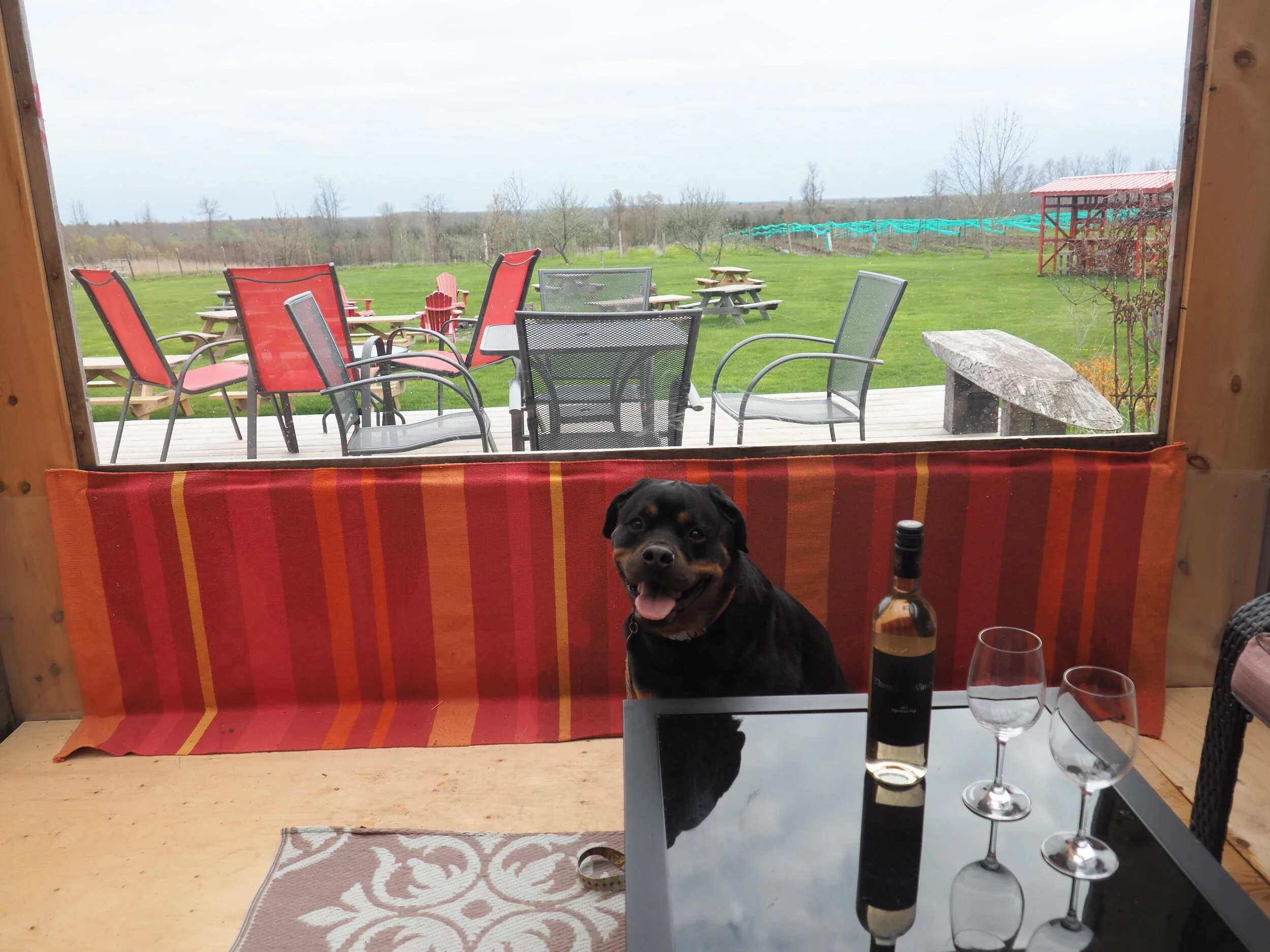Practice these tips at home to prepare your dog for the patio (Photo: dog laying on a balcony with table and chairs in the background)
A new law in 2020 now allows bars and restaurants the option of allowing puppies on their patios in Ontario. Imagine your dog stretched out beneath your table while you enjoy the summer breeze, good food, and great conversation.
Are you worried that your dog will tangle up the server, lunge at the dog under the next table, or stare at the other diners and drool the entire time?
Are you afraid of what your dog might do to embarrass you at a patio? (Photo: two Pekinese dogs with tangled leashes)
We understand how stressful it can be to try to train your dog to relax for five minutes, let alone while you eat an entire meal. By breaking down the training process into manageable bite-sized bits, you can be the envy of all the other diners. You can be the one leaning back in her chair, casually sipping wine, and laughing at her friend’s story about her insane boss. Here are three tips to get you started.
EXERCISE — Be sure to exercise your dog before heading out to the patio. If you have a breed that requires loads of exercise, like a Husky or a Rhodesian Ridgeback, this may mean a long bike ride, hike, or fetch session. When you have fulfilled your dog’s needs, they will be far more willing to go into rest-mode while you sip your cider.
Be sure to exercise your dog before bringing them to a patio (Photo: two dogs wrestle on a lawn)
2. ACTIVITIES — You wouldn’t expect your kids to survive a long meal at a restaurant without toys or activity books. Restaurant owners often provide colouring mats and crayons to children, but they won’t have anything available for your dog. Bring a bone, bully stick, or a rubber toy stuffed with frozen treats along to entertain your dog. Do not bring these items if your dog is a resource guarder (has issues with food aggression/toy aggression,) as there is no guarantee that there won’t be other dogs around. Also, be aware that other dogs may have these issues, even if your dog is lovely and shares everything with everyone. Be aware of your surroundings and adjust accordingly.
Bring your dog something to do/chew (Photo: beagle chewing a bone)
3. PRACTICE LIKE YOU PLAY — I’ve been an athlete all my life. I’ve had many amazing coaches and the best ones made sure that we practiced like we played. What does that mean? It means you give 100% at practice or you ride the pine (sit on the bench) on game day. You can’t give a 50% effort into training your dog and then expect a perfect performance on game day (or patio day, as the case may be.) If your goal is to have a dog who can lie under your table at a restaurant for hours on end, not growl and lunge at other dogs, not beg for food, and not jump on passersby, then you need to teach your dog all of those little pieces. Think of each one as a puzzle piece. Write them down. Commit. Check them off one by one, before expecting your dog to magically do all of them on her own. Could you have excelled in every game or activity you enjoyed without coaching? Without practice?
Practice in many locations: in your home, in your yard, at your friend’s cottage (Photo: (three dogs lounge on a deck while attentively watching their human)
Here’s a list of a few simple commands to work on to prepare for patio day:
-sit
-stay
-down
-off (so they don’t jump on strangers or put their paws on the table)
-leave it (so if food falls on the floor, they don’t snatch it up)
-drop it/aus — the backup plan if they DO snatch up food that falls from the table
All of these commands come in very handy at home, on hikes, and at backyard BBQs as well.
Here is a picture of Magic at Three Dog Winery in Prince Edward County. While we were lounging, an off-leash dog came over (his owner had no idea we were there.) Luckily both of our dogs were friendly and up for a wee visit, and happily — no wagging tails spilled our wine.
(Magic the Rottweiler poses at Three Dog Winery in Prince Edward County)
It takes time to build a strong relationship with any dog. Take your time, enjoy the process, and be patient with yourself and your dog. You’ll get there.
Happy training, Dog Leaders!!
Alyssa
Photos by: Lia Tzanidaki (dog laying on a balcony with table and chairs in the background,) David Taffet (two dogs wrestle on a lawn,) Aditya Joshi (beagle chewing a bone,) Jason Dean Chamberlain (three dogs lounge on a deck while attentively watching their human,) Collins Lesulie (two Pekinese dogs with tangled leashes,) Alyssa Foulkes (Magic the Rottweiler poses at Three Dog Winery in Prince Edward County.)





















































